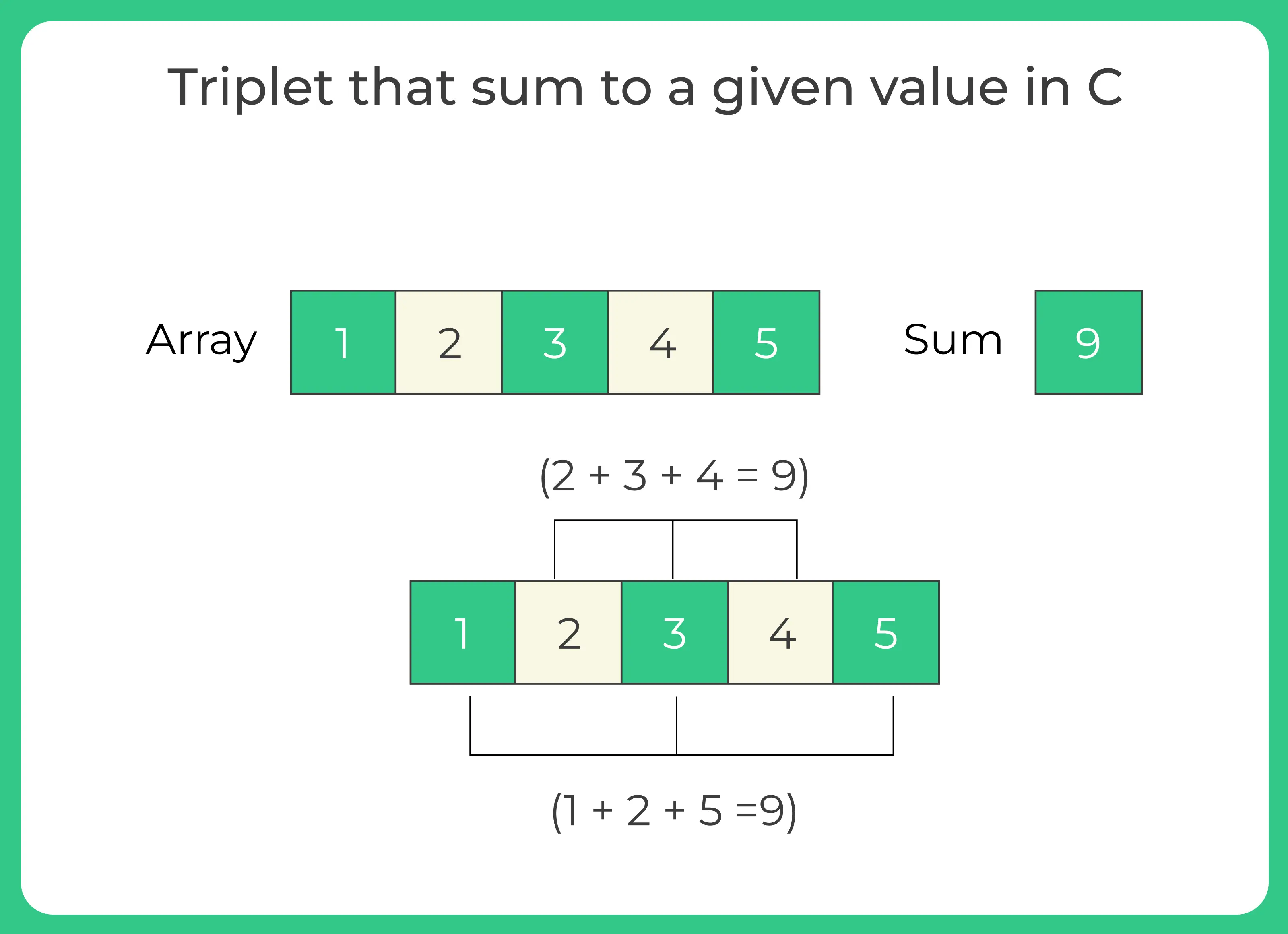0
Notifications Mark All Read
- Login
- Get Prime
Triplet that sum to a given value in C
Triplet that sum to a given value
On this page we will discuss about triplet that sum to a given value in C. Given an array and a value, find if there is a triplet in array whose sum is equal to the given value. If there is such a triplet present in array, then print the triplet and return true. Else return false.

Triplet that Sum to Given Value in C
A triplet that sums to a given value C is a set of three elements in an array whose sum is equal to C. For example, if we have an array [1, 2, 3, 4, 5] and the target sum C is 9, then the triplet that sums to C is (2, 3, 4) because 2 + 3 + 4 = 9.
In general, given an array of n elements and a target sum C, the problem is to find all triplets (a, b, c) in the array such that a + b + c = C. The triplets may or may not be unique, and the order of the elements in each triplet does not matter.
On this page we will discuss two different methods for this-
- Naive Approach
- Sorting Approach

- Naive approach: Naive approach uses a nested loop to check all possible subarrays of the given array. For each starting index i, it checks all subarrays starting from i and ending at j, and calculates their sum. If the sum is equal to the given sum, it prints the indices of the subarray and returns. If no subarray is found, it prints a message indicating that no subarray was found.
Algorithm:
- Take size of the array from the user and store it in a variable say n.
- Now take n elements of the array from the user.
- Take one more interger value o
- Create three nested loop first loop runs from start to end (loop counter i), the second loop runs from i+1 to end (loop counter j) and the third loop runs from j+1 to end (loop counter k)
- The counter of these loops represents the index of 3 elements of the triplets.
- Find the sum of the ith, jth and kth element. If the sum is equal to a given sum. Print the triplet and break.
- If there is no triplet, then print “No triplet exists”.
C Code for naive approach
#include <stdio.h>
void findTriplets (int arr[], int n, int C)
{
for (int i = 0; i < n - 2; i++)
{
for (int j = i + 1; j < n - 1; j++)
{
for (int k = j + 1; k < n; k++)
{
if (arr[i] + arr[j] + arr[k] == C)
{
printf ("(%d, %d, %d)\n", arr[i], arr[j], arr[k]);
}
}
}
}
}
int main ()
{
int arr[] = { 1, 2, 3, 4, 5 };
printf ("Array: ");
int n = sizeof (arr) / sizeof (arr[0]);
for (int i = 0; i < n; i++)
{
printf ("%d ", arr[i]);
}
int sum = 9;
printf ("\nsum: %d", sum);
printf ("\nTriplets:\n");
findTriplets (arr, n, sum);
return 0;
}
Output
Array: 1 2 3 4 5 sum: 9 Triplets: (1, 3, 5) (2, 3, 4)
- sorting approach: The sorting approach involves sorting the given array and then using two pointers to find triplets that sum to the given value C. This approach has a time complexity of O(n^2), where n is the size of the array.
Algorithm:
- sort the array arr in ascending order
- for i = 0 to n-2:
- j = i+1
- k = n-1
- while j < k:
- if arr[i] + arr[j] + arr[k] == C:
- print (arr[i], arr[j], arr[k])
- j = j+1
- k = k-1
- else if arr[i] + arr[j] + arr[k] < C:
- j = j+1
- else:
- k = k-1
C Code for sorting approach
#include <stdio.h>
void sort (int arr[], int n)
{
int i, element, j;
for (i = 1; i < n; i++) { element = arr[i]; j = i - 1; while (j >= 0 && arr[j] > element)
{
arr[j + 1] = arr[j];
j = j - 1;
}
arr[j + 1] = element;
}
}
void findTriplets (int arr[], int n, int sum)
{
sort (arr, n);
for (int i = 0; i < n - 2; i++)
{
int j = i + 1;
int k = n - 1;
while (j < k)
{
if (arr[i] + arr[j] + arr[k] == sum)
{
printf ("(%d, %d, %d)\n", arr[i], arr[j], arr[k]);
j++;
k--;
}
else if (arr[i] + arr[j] + arr[k] < sum)
{
j++;
}
else
{
k--;
}
}
}
}
int main ()
{
int arr[] = { 1, 2, 3, 4, 5 };
printf ("Array: ");
int n = sizeof (arr) / sizeof (arr[0]);
for (int i = 0; i < n; i++)
{
printf ("%d ", arr[i]);
}
int sum = 9;
printf ("\nsum: %d", sum);
printf ("\nTriplets:\n");
findTriplets (arr, n, sum);
return 0;
}
Output
Array: 1 2 3 4 5 sum: 9 Triplets: (1, 3, 5) (2, 3, 4)
Prime Course Trailer
Related Banners
Get PrepInsta Prime & get Access to all 200+ courses offered by PrepInsta in One Subscription
Get over 200+ course One Subscription
Courses like AI/ML, Cloud Computing, Ethical Hacking, C, C++, Java, Python, DSA (All Languages), Competitive Coding (All Languages), TCS, Infosys, Wipro, Amazon, DBMS, SQL and others
Introduction to Trees
Binary Trees
- Binary Tree in Data Structures (Introduction)
- Tree Traversals: Inorder Postorder Preorder : C | C++ | Java
- Inorder Postorder PreOrder Traversals Examples
- Tree Traversal without Recursion
Binary Search Trees
Traversals
- Traversal in Trees
- Tree Traversals: Breadth-First Search (BFS) : C | C++ | Java
- Tree Traversals: Depth First Search (DFS) : C | C++ | Java
- Construct a Binary Tree from Postorder and Inorder
B – Trees
AVL Trees
- AVL Trees
Complete Programs for Trees
- Depth First Traversals – C | C++ | Java
- Level Order Traversal – C | C++ | Java
- Construct Tree from given Inorder and Preorder traversals – C | C++ | Java
- Construct Tree from given Postorder and Inorder traversals – C | C++ | Java
- Construct Tree from given Postorder and Preorder traversal – C | C++ | Java
- Find size of the Binary tree – C | C++ | Java
- Find the height of binary tree – C | C++ | Java
- Find maximum in binary tree – C | C++ | Java
- Check whether two tree are identical- C| C++| Java
- Spiral Order traversal of Tree- C | C++| Java
- Level Order Traversal Line by Line – C | C++| Java
- Hand shaking lemma and some Impotant Tree Properties.
- Check If binary tree if Foldable or not.- C| C++| Java
- check whether tree is Symmetric – C| C++| Java.
- Check for Children-Sum in Binary Tree- C|C++| Java
- Sum of all nodes in Binary Tree- C | C++ | Java
- Lowest Common Ancestor in Binary Tree- C | C++ | Java
Introduction to Trees
Binary Trees
- Binary Tree in Data Structures (Introduction)
- Tree Traversals: Inorder Postorder Preorder : C | C++ | Java
- Inorder Postorder PreOrder Traversals Examples
- Tree Traversal without Recursion
Binary Search Trees
Traversals
- Traversal in Trees
- Tree Traversals: Breadth-First Search (BFS) : C | C++ | Java
- Tree Traversals: Depth First Search (DFS) : C | C++ | Java
- Construct a Binary Tree from Postorder and Inorder
B – Trees
AVL Trees
- AVL Trees
Complete Programs for Trees
- Depth First Traversals – C | C++ | Java
- Level Order Traversal – C | C++ | Java
- Construct Tree from given Inorder and Preorder traversals – C | C++ | Java
- Construct Tree from given Postorder and Inorder traversals – C | C++ | Java
- Construct Tree from given Postorder and Preorder traversal – C | C++ | Java
- Find size of the Binary tree – C | C++ | Java
- Find the height of binary tree – C | C++ | Java
- Find maximum in binary tree – C | C++ | Java
- Check whether two tree are identical- C| C++| Java
- Spiral Order traversal of Tree- C | C++| Java
- Level Order Traversal LIne by Line – C | C++| Java
- Hand shaking lemma and some Impotant Tree Properties.
- Check If binary tree if Foldable or not.- C| C++| Java
- check whether tree is Symmetric C| C++| Java.
- Check for Children-Sum in Binary Tree- C|C++| Java
- Sum of all nodes in Binary Tree- C | C++ | Java
- Lowest Common Ancestor in Binary Tree. C | C++ | Java

 0
0



Login/Signup to comment